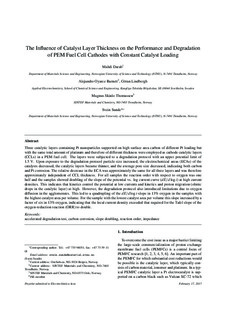The Influence of Catalyst Layer Thickness on the Performance and Degradation of PEM Fuel Cell Cathodes with Constant Catalyst Loading
Journal article
Submitted version

View/
Date
2017Metadata
Show full item recordCollections
- Institutt for materialteknologi [2540]
- Publikasjoner fra CRIStin - NTNU [37737]
Abstract
Three catalytic layers containing Pt nanoparticles supported on high surface area carbon of different Pt loading but with the same total amount of platinum and therefore of different thickness were employed as cathode catalytic layers (CCLs) in a PEM fuel cell. The layers were subjected to a degradation protocol with an upper potential limit of 1.5 V. Upon exposure to the degradation protocol particle size increased, the electrochemical areas (ECAs) of the catalysts decreased, the catalytic layers became thinner, and the average pore size decreased, indicating both carbon and Pt corrosion. The relative decrease in the ECA was approximately the same for all three layers and was therefore approximately independent of CCL thickness. For all samples the reaction order with respect to oxygen was one half and the samples showed doubling of the slope of the potential vs. log current curve (dE/d logi) at high current densities. This indicates that kinetics control the potential at low currents and kinetics and proton migration (ohmic drops in the catalytic layer) at high. However, the degradation protocol also introduced limitations due to oxygen diffusion in the agglomerates. This led to a quadrupling of the dE/d logi-slope in 13% oxygen in the samples with the highest catalyst area per volume. For the sample with the lowest catalyst area per volume this slope increased by a factor of six in 13% oxygen, indicating that the local current density exceeded that required for the Tafel slope of the oxygen-reduction reaction (ORR) to double.